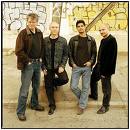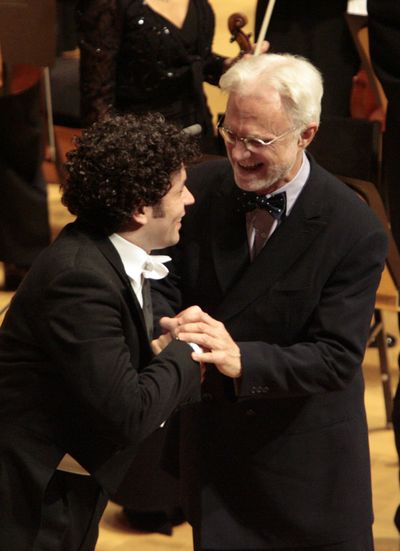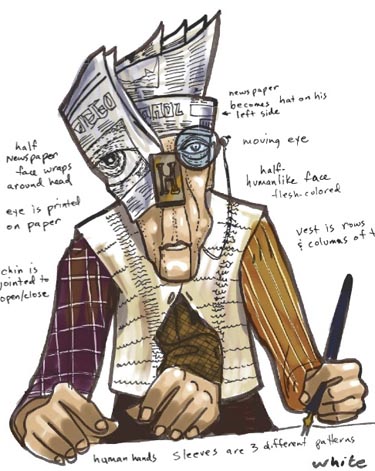 Had an unusual performance experience yesterday which threw up some thoughts about the nature of the exchange that happens between performers and audiences. I was part of a small group of singers drafted under the auspices of a current member of the University of California at San Francisco medical faculty to perform songs for patients on the wards of the university cancer center. I jumped at the chance to sing with this group because I have been interested for a while in the efficacy of arts programs in hospitals and heard great things about the uplifting effect that singing can have on the spirits of people in poor health.
Had an unusual performance experience yesterday which threw up some thoughts about the nature of the exchange that happens between performers and audiences. I was part of a small group of singers drafted under the auspices of a current member of the University of California at San Francisco medical faculty to perform songs for patients on the wards of the university cancer center. I jumped at the chance to sing with this group because I have been interested for a while in the efficacy of arts programs in hospitals and heard great things about the uplifting effect that singing can have on the spirits of people in poor health.
We spent a couple of hours in the afternoon wedged first in the corner of a waiting room and second in a small lounge area where we performed a selection of a cappella songs — madrigals, show tunes and standards mostly.
What was strange about the experience from a performer’s perspective was how seemingly disinterested or even absent our target audience was. In the waiting room, the listeners were all lined up against a wall wearing protective face masks. Hardly any of them looked our way and no one applauded. When we were done, we just shuffled out without a word. Everyone in the room stared blankly ahead of them. We did get an appreciative nod from one or two nearby staffers though. I was happy to sing, but I couldn’t help wondering if the patients would much rather we hadn’t been there interrupting their peace. After all, we were intruders; they couldn’t leave the room. The situation in the coffee lounge was possibly even weirder. The nurse seemed happy to see us and said she’d send word around. But for the first 15 minutes of our set no one came so we sang for ourselves. Eventually three people turned up but none of them were patients. I think one was a nurse and the other two, visiting relatives of a patient. They seemed to enjoy the music. But, again, these were not the people we had been drafted in to perform for.
Now, I don’t mean to sound like all I care about is audience attention. But it does seem a little odd to rehearse for weeks within the framework of an organized hospital arts program only to fail to connect in any way with the target audience. Perhaps patients who heard our singing down the hallway did get something (hopefully positive) out of the music. Maybe the fact that we showed up is all that matters. It’s not about us, after all; it’s about them. On the other hand, might our efforts be more useful to the hospital if we actually got to sing in front of patients, preferably ones who knew we were coming and wanted to hear us?
I’m going back to UCSF next Tuesday. I hear from our industrious and dedicated music director, Debbie, that every performance that the group has undertaken so far at the hospital is different. (I was in Los Angeles for the first few outings, so yesterday was my debut as part of the ensemble.) So maybe next time we’ll have a genuine audience. But here’s a question: Is it enough simply to show up and sing on a cancer ward? Or is the exercise pointless if your target audience is seemingly disinterested or completely absent?

 Real sorrow is very hard to pull off on stage or screen. I often think that if you want audiences to feel the weight of a character’s woes as a screen or playwright, you’re usually better off getting them to do something funny, rather than give them a crying scene. It’s just really hard to act sadness convincingly. Even if we can see that a character is deeply upset about something, it’s a rare actor who can make us actually feel their pain.
Real sorrow is very hard to pull off on stage or screen. I often think that if you want audiences to feel the weight of a character’s woes as a screen or playwright, you’re usually better off getting them to do something funny, rather than give them a crying scene. It’s just really hard to act sadness convincingly. Even if we can see that a character is deeply upset about something, it’s a rare actor who can make us actually feel their pain. Perhaps the most interesting detail that came up in last night’s Theatre Critics’ Panel organized by
Perhaps the most interesting detail that came up in last night’s Theatre Critics’ Panel organized by  One of the least satisfying musical experiences I think I’ve ever had was catching Bob Dylan at the Greek Theatre in Berkeley in 2002. This is really saying something as the combination of Great Bob and the Greek ought to have been a recipe for perfection. But the singer sadly failed to deliver. He played the piano badly, slurred and bleated his words more than I’ve ever heard him do previously and generally made every song sound unintelligible. My friend and I spent the entire gig playing a game of “guess which famous Bob Dylan song the singer is singing right now?” More often than not, we couldn’t make out the titles of his most beloved hits until the songs were halfway through.
One of the least satisfying musical experiences I think I’ve ever had was catching Bob Dylan at the Greek Theatre in Berkeley in 2002. This is really saying something as the combination of Great Bob and the Greek ought to have been a recipe for perfection. But the singer sadly failed to deliver. He played the piano badly, slurred and bleated his words more than I’ve ever heard him do previously and generally made every song sound unintelligible. My friend and I spent the entire gig playing a game of “guess which famous Bob Dylan song the singer is singing right now?” More often than not, we couldn’t make out the titles of his most beloved hits until the songs were halfway through.
 It’s been a fiendish day what with hangovers and three hours of sleep to contend with. On the positive side, these signs point to the fact that Gustavo Dudamel’s debut at Walt Disney Concert Hall as the
It’s been a fiendish day what with hangovers and three hours of sleep to contend with. On the positive side, these signs point to the fact that Gustavo Dudamel’s debut at Walt Disney Concert Hall as the  Radio presenters — especially ones engaged in hosting cultural programs — are very particular about the way they pronounce proper nouns. This is of course very important: You have to get names right or you risk causing offense to the bearer of the noun in question and/or being completely misunderstood by listeners.
Radio presenters — especially ones engaged in hosting cultural programs — are very particular about the way they pronounce proper nouns. This is of course very important: You have to get names right or you risk causing offense to the bearer of the noun in question and/or being completely misunderstood by listeners. Never before have I been in a theatre with so many sleeping people.
Never before have I been in a theatre with so many sleeping people. The people of the
The people of the  Just about every minute of the five hours I spent sitting in the nosebleeds at the Hollywood Bowl in Los Angeles was worth the one and a half hour slog in the broiling heat I undertook to reach the venue from my friend’s place in West Hollywood on Saturday afternoon. The occasion — Gustavo Dudamel’s inaugural appearance as music director of the
Just about every minute of the five hours I spent sitting in the nosebleeds at the Hollywood Bowl in Los Angeles was worth the one and a half hour slog in the broiling heat I undertook to reach the venue from my friend’s place in West Hollywood on Saturday afternoon. The occasion — Gustavo Dudamel’s inaugural appearance as music director of the  The first ever
The first ever  Tomorrow, – October 2 from 9AM-1PM PDT – The Annenberg School of Journalism, USC, is hosting its first ever National Summit on Arts Journalism. The summit will present ten projects in arts journalism from around America, each one geared towards saying something interesting about the future of how we cover the arts. The event will take place in the auditorium of the journalism school in front of an audience of 200 (I’ll be there!), but it’s primarily conceived of as a virtual online event. The Summit will be streamed
Tomorrow, – October 2 from 9AM-1PM PDT – The Annenberg School of Journalism, USC, is hosting its first ever National Summit on Arts Journalism. The summit will present ten projects in arts journalism from around America, each one geared towards saying something interesting about the future of how we cover the arts. The event will take place in the auditorium of the journalism school in front of an audience of 200 (I’ll be there!), but it’s primarily conceived of as a virtual online event. The Summit will be streamed